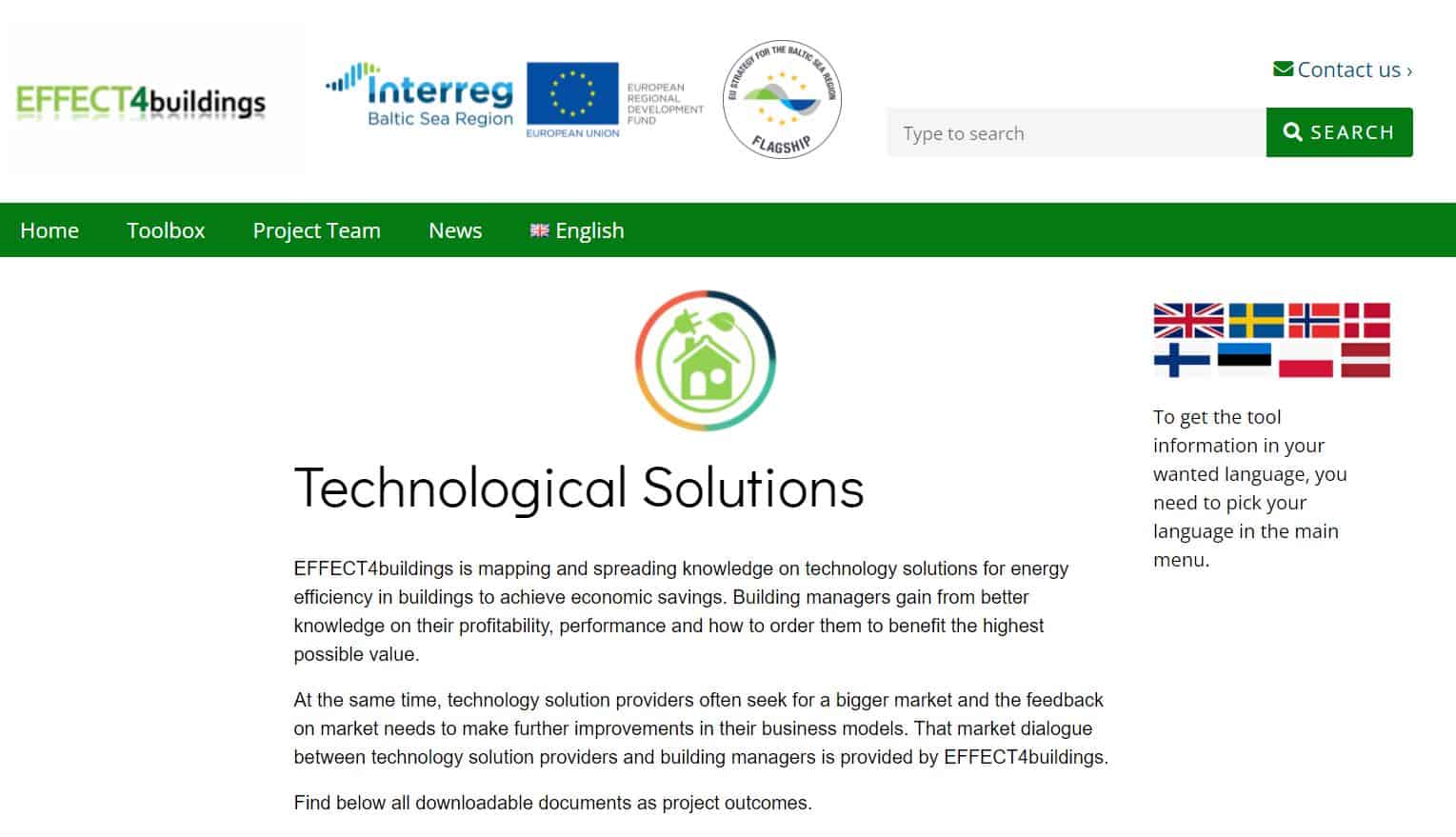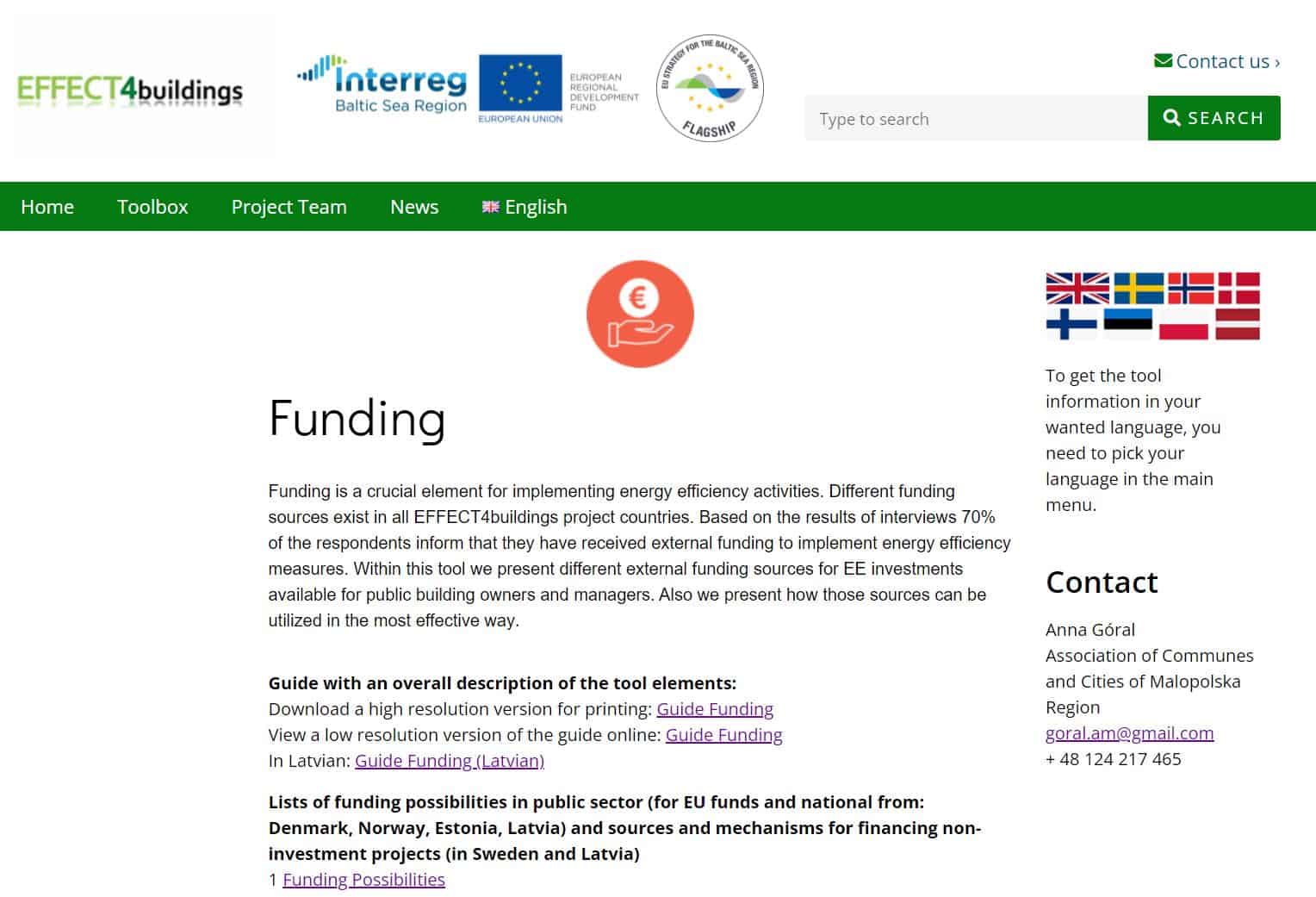EFFECT4buildings
Public authorities play a crucial role in the renovation of existing public buildings and in reaching satisfying energy efficiency targets in buildings. However, they often lack tools supporting their decision-making to actually move ahead with implementing energy efficiency measures.
A need to make investments profitable
Energy efficiency projects are not typical investments because they rarely result in direct revenue. In addition, a lack of knowledge and records of successful experiences increases the anticipated risks of undertaking such projects. Finding convincing investors that see energy efficiency measures as promising investments is, therefore, a challenge. These challenges which public building managers face do not differ much from the challenges concerning privately owned buildings and, to a large extent, also industry-owned buildings.
Other obstacles to overcome
Additionally, technology providers often seek a bigger market and a clear picture of the demand. Furthermore, existing legal and structural frameworks hinder the possibility for building owners to become energy producers. Last but not least, in order to convince financial managers public authorities need a better understanding of energy calculations and profitabilities. In order to address these challenges, EFFECT4buildings developed a decision support toolbox for the calculation and planning of renovation projects in the most feasible and profitable way.
Budgets
in numbers
-
2.72MillionTotal
-
1.91MillionErdf
-
0.00MillionEni + Russia
-
0.15MillionNorway
Achievements
Real-life cases organised
The project EFFECT4buildings organised about 60 trainings and seminars reaching out to about 2600 people, mainly building managers from eight Baltic Sea region countries. The project partners applied retrofitting, upgrading, and deep renovation as energy efficiency measures. The project involved the trained building managers in 120 real-life cases to develop and adjust 9 tools for spreading knowledge and supporting the use of measures. These 120 cases amount to around EUR 9,157,828 of investment in energy efficiency and to up 5.700.000 kWh/year of energy savings.
Useful tools developed
The project developed an online toolbox that includes tools on technological solutions, calculations, and funding. Thanks to the catalogue on technology solutions, building managers could better understand the profitability, performance, and how to make the most out of solutions, while providers received an entry point to a bigger market for their solutions.
As regards financial calculations, the project enabled to predict the profitability of an investment which is critical for building managers, energy auditors and other investors to make decisions on energy efficiency measures. Next, on funding the project compiled a comprehensive list with the funding possibilities in the public sector (EU and national funds from Denmark, Norway, Estonia, Latvia, Poland, Finland, Sweden), as well as from international and national non-public sources and mechanisms.
The project made available the toolbox in English, Finnish, Polish and Latvian and ensured its searchability making it available at the project portal and as featured in the European Portal for Energy Efficiency in Buildings.
Inspired by the project
As concrete examples on the municipal level, Aurskog-Høland municipality (NO) started the process of implementing Energy Performance Contracting (EPC) which stands for a provision of energy services with a guaranteed outcome. One of the main principles is that investment financing is performed by using accumulated savings. Next, Hamar municipality (NO) set the commitment to include an EPC project in the municipality´s Sustainable Energy Action Plan.
Furthermore, GreenEst Summit started as a project event and continues to be organised annually as the conference on innovations in the energy sector. The County Board of Dalarna (SE) initiated a new stakeholder cooperation forum with all energy companies in the Dalarna region to work together on power loads and grid capacity for solar energy.
With EUR 2.66 million support from the European Union, the Interreg project EFFECT4buildings improved the capacity of public building managers to unlock investments, lower risks, and implement energy efficiency measures in publicly-owned buildings.
Outputs
Technological solutions toolbox

Financial calculations toolbox

Funding toolbox

Project Stories
Partners
County board of Dalarna
- TownFalun
- RegionDalarnas län
- CountrySweden
- RepresentativeMarit Ragnarsson
- Phone
- E-Mail
- Web
Environmental office of Lappeenranta region
- TownLappeenranta
- RegionEtelä-Karjala
- CountryFinland
- RepresentativeIlkka Räsänen
- Phone
- E-Mail
- Web
SUCCEEDED by PP12 (01.01.2020) Hedmark county council
- TownHamar
- RegionHedmark
- CountryNorway
- RepresentativeKjell Vaagen
- Phone
- E-Mail
- Web
Vidzeme planning region
- TownCesis
- RegionVidzeme
- CountryLatvia
- RepresentativeAija Ruse
- Phone
- E-Mail
- Web
Gate 21
- TownAlbertslund
- RegionKøbenhavns omegn
- CountryDenmark
- RepresentativeKarolina Huss
- Phone
- E-Mail
- Web
Foundation Tallinn Science Park Tehnopol
- TownTallinn
- RegionPõhja-Eesti
- CountryEstonia
- RepresentativeKairi Sülla
- Phone
- E-Mail
- Web
State Real Estate Ltd
- TownTallinn
- RegionPõhja-Eesti
- CountryEstonia
- RepresentativeMikk Maivel
- Phone
- E-Mail
- Web
Sustainable Building Cluster in Dalarna
- TownFalun
- RegionDalarnas län
- CountrySweden
- RepresentativeÅke Persson
- Phone
- E-Mail
- Web
Association of Communes and Cities of Małopolska Region
- TownKrakow
- RegionMiasto Kraków
- CountryPoland
- RepresentativeAnna Góral
- Phone
- E-Mail
- Web
Inland County Council
- TownHamar
- RegionHedmark
- CountryNorway
- RepresentativeLiv Randi Lindseth
- Phone
- E-Mail
- Web
-
Project managerMarit RagnarssonCounty Board of Dalarna
-
Legal representativeCamilla FagerbergCounty board of Dalarna
-
Financial managerLiina LuupInterreg Consulting
-
Communication managerBaiba NorberteVidzeme Planning Region



